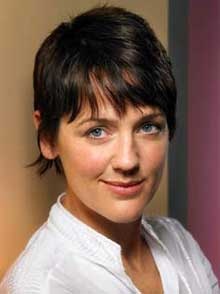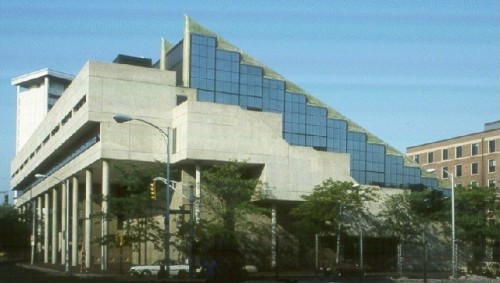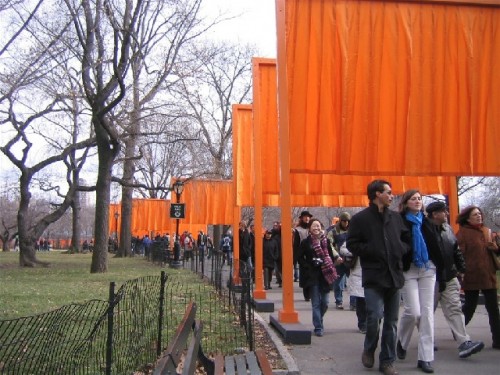Art In the Life of the City: Learning from London
A Symposium At The Harvard Design School
By: Mark Favermann - Apr 22, 2008
April 17 and 18, 2008At Piper Auditorium
The Graduate School Of Design
Harvard University
Cambridge, MA
Organized by Camilla Ween, an architect/urban designer for Transport London
Sponsored by the Loeb Fellowship Program
The Graduate School of Design (GSD), Harvard University's Design School, is arguably, as most other professional schools at Harvard, the best of its kind. It's architecture program and landscape architecture programs are historically ranked as the top masters in their fields. More recently, after a strange and convoluted process that warrants its own article, the GSD's planning and urban design program is on the rise as well setting standards for topical discourse and academic as well as professional research and investigation.
The GSD offers a doctor of design degree and a research-oriented mid-career masters of design as well. It has historically always had an ability to attract top students and top visiting faculty and design critics. The GSD has always had a strong and often vibrant speakers series focused on topics relevant to the professional interests of the school and often topically contextual. However, recently the Harvard Design School has started to developed a masterly touch in creating conferences and symposia that go beyond typical design discourse but instead seem to achieve a distinctive level of quality and contemporary resonance.
For example, during March, the GSD-China Association held a corporately sponsored symposium on Beijing and the Olympics called Archi-Olympics attended by over 250 people. It included a number of individuals from Beijing and looked at recent architectural projects as well as issues involved with the Olympics including the Tibet uprisings and conflicts. Two weeks following, there was a major presentation by Peter Walker, the eminent landscape architect, who spoke about his work on the Ground Zero 9/11 Memorial ("Edifice Wrecks,"www.berkshirefinearts.com, 2008-3-29). He said that this was the hardest job that he ever took on. Another large crowd attended.
And then April 17 and 18, the GSD hosted a public art symposium. This is the first in-depth conference that has ever been held at the school dealing with public art. Unlike the primary emphasis of the Design School on permanent structures and projects, interestingly, the focus of the symposium was on temporal projects and events.
The keynote speaker Claire Doherty, Director of the Situations Program in Bristol, England and a Senior Research Fellow in Fine Arts at the University of the West of England and other leading curators from London discussed the impact of large temporary or ephemoral public art installations upon their institutions and the urban fabric. Talks explained and described a variety of compelling projects and programs. Harvard GSD faculty members were integrated into the symposium as panel moderators and summarizers.
The individual projects and continuing programs included temporary one-day public arts events in Bristol, the Fourth Plinth sculpture in Trafalgar Square (Is Public Art Fair in Trafalgar Square, December 12, 2007, www.berkshirefinearts.com), the architectural summer pavilions at the Serpentine Gallery in Hyde Park, the large special installation commissions for the Turbine Hall in Tate Modern, the Sultan's Elephant 'street theater,' and other successful public art projects in recent years in and around London. Knowledgeable Cambridge-based public artist Ross Miller presented his own unique artworks and perspective as well.
The keynote speech on Thursday was intellectually as well as aesthetically provocative, easily the most problematic and probably the most academic presented. The speaker Claire Doherty, a curator and writer, who was curator at Ikon Gallery in Birmingham, previously developed a new curatorial program for Spike Island in Bristol. Subsequently she has completed various independent curatorial projects including being an associate curator for a project in Liverpool.
Her current role at the University of the West of England involves her in a research and commissioning program that's mission states is devised to investigate the significance of place and context in contemporary art. She is literally an activist programmer and facilitator of art events and projects. These new curators greatly expand the boundaries of institutionally managed art into the public sphere. Literally, commissioning artwork from artists, they are intrinsically involved in the artistic process, not just choosing works of art, but literally facilitating the whole process by raising funds to pay the artists and dealing with the institutional as well as civic or regional bureaucracies. I cannot see many American art historian academics or museum curators having the interest or ability to foster public art programming. The United Kingdom's curators are gifted by a generous financial alottment by the British government through the National Lottery to the rather enlightened British Arts Council. How unAmerican this is as well.
Though she is relatively young, she oddly seems to be the senior "new curator," as the other curator/speakers seem to defer to her during their own presentations. This is a British or perhaps European public art that is on the outside of the art institution but connected to it. This is all rather brave and good. However, her interpretation of this art as somehow new was rather jarring. In her rather academically presented paper, she did give a nod to the "happenings" of the late 1950's and 1960's first initiated by Allan Kaprow. But, she lightly skimmed over the hippie culture's own often organic events and those by serious artists of the period like Carolee Schneemann, Red Grooms, Robert Rauschenberg, Jim Dine, Claus Oldenberg, Adrian Henri and others. To Doherty, this ephemeral art is something so new and even so radical.
It should be remembered that a happening was and is a performance, an event or even a situation meant to be considered as art. Happenings take place anywhere, are often multi-disciplinary, often lack a narrative and frequently seek to involve and interact with the audience in some way. Key elements of happenings are planned, but artists sometimes allow for spontaneity and improvisation. During the 1970's and 1980's , Conceptual Art evolved from the less formal happenings with the interaction with the public or audience either environmentally involved or intellectually evolved. Often it was both.
This is not very different from the art events that Doherty espouses. Her emphasis on the newness of the "situation" or event is conceived as having a radical shift. This supposedly radical aspect is couched in the technology of our times--cell phone images, digital cameras, internet connections, emails, instant IMing, YouTube films, etc., or what she refers to as an explosion of information and communication connections. She feels that the recent technologies somehow de-objectify the art and feels that this somehow makes this art different and even radical.
In her essay, "Public Art as Situation: Towards an Aesthetics of the Wrong Place in Contemporary Art Practice and Commissioning," she sees inherent contradictions of placeÂbased art commissioning. Her feeling is that there are multiple temporal and discursive layers through which artists are now working, that can only be experienced as a cumulative engagement between artists and the city. She views the most successful art works as those which seemed to offer some resistance to a nostalgic or literal representation of a city or traditional urban setting. She further embraces the idea that these reflect a complicit relationship between the curator and artist effecting a kind of sense of "being in the wrong place", a sense of dislocation, or displacement. To her this is an expression of a new type of art.
Her view is that "the rhetoric of place," not the place itself or its context, has become the primary motivating force for the commissioning of contemporary art. She uses examples of art event commissions in cities throughout Europe in the last seven years or so-- in Liverpool, Istanbul, Muenster and other cities. She feels that this ephemeral public art needs to be wide and shallow in terms of public engagement rather than narrow and deep – sightseeing rather than insightful. In artspeak, she described the public art program in Istanbul as "creating intersections between local and international, and eschewing locations which might endorse a nostalgic or exotic view of the city." Furthermore, with the integration of critical platforms within the resulting exhibition, the curators established active participation as a key component of the public manifestation of the commissioned temporary art, not just part of a research process. I am not quite sure what this vague phrasing means. Perhaps the ambiguity is part of the curatorial and artistic interplay?
Ms. Dougherty further speculates "that if place is the motivating force behind a project, it is imperative for commissioners and curators to encourage an artist's engagement with place as a mutable concept (an intersection of mapped location, urban mythology, power dynamics and social interaction), and that this may occur through a variety of different modes of exchange – long term residencies and short term visits, interdisciplinary collaborations, urban interventions and critical platforms. What may distinguish 'successful' projects from the more literal or spectacular projects is the curator's capacity to allow projects to emerge over time in different guises and the artist's ability to understand how to move beyond a mere confirmation of existing aspects of place identity." What?
Claire Doherty states that she recognizes the most interesting practices in public space as experiential and highly visual, interdisciplinary involving not only other art forms, but other fields of knowledge and are lastly, spectacularly engaging. These projects effect a sense of the wrong place by shifting the status quo, by intervening in the bordered, prescribed spaces of location. And, consequently, these temporary projects also have the opportunity to operate beyond time and place of the originating context.
A major example of this was showcased by her. It was the image of a jack-knifed white lorry (truck) that closed a street in downtown Bristol. Apparently, the truck was set up to look like an accident. Out of the truck's back were strewn many different colored flowers that appeared to be headed for a large florist market. This "artistic disaster" was an interactive event that lasted for less than a day. Doherty states that this artistic moment involved the displacement of the community through conversations, rumors, emails, text messages and cell phone photographs. At the end of the day, Bristol residents waited politely in line and took every flower that was in and out of the lorry. She said that this art situation was particularly successful. I am not sure what this quite means. Was it successful in terms of social interaction? How successful was it as an art piece? Anything can be intellectually justified. But aesthetically? But clearly, she is very serious and is highly thought of in the curatorial world.
Doherty states, "The experience of art is not one in my opinion that necessarily restores a sense of belonging or offers up a moment of resolution, but if truly place-Âresponsive, situation-specific and contemporary, that work of art will shatter the fictions of a stable sense of place, will intervene in the status quo and literally shift the ground beneath your feet." More artspeak, but this is suggesting that the object is non-existent when in cyberspace. Historically, conceptual artists like Douglas Huebler created non-objective objects in the 1970's. He produced works in numerous media often involving documentation, maps and text to explore social environments and the effect of passing time on objects. Therefore, it appears that there is not much new except for media type and distribution.
Christo's projects are all temporal even ephemeral. His renderings, collages, prints and plans before the event and his documentation after including photos, documentary films, television shows and books help pay for the costs of the temporary art pieces. The permanent objects that he creates for sale support the temporay pieces. The Central Park "Gateways" is one in a long line of his pieces. These projects have been going on for nearly 40 years. They are all extremely successful.
The process and approach are certainly not new. What do the French say? It seems that the more things seem to change, the more things are the same. Temporary art, conceptual art or ephemeral art, whatever it is called, set in an urban context, have a temporary impact upon that setting. Considering this artwork interesting, provocative or even unimportant is certainly nothing new. Celebrating it and more easily funding it by curators may be a different approach.
A personal note: In 1974-76, after losing two permanent sculpture commissions--one in a competition and the other by community manipulation by the architects/planners, I got a small travel grant to create public sculptural events around the United States. I turned major monuments literally and conceptually into temporary sundials. My work was clearly temporal. Its ephemeral nature was erroded by weather and time. The drawings, diagrams, maps and photographic documentation (the media of the time) were shown at the OK Harris Gallery in New York City in a small one-man show in May-June of 1976. It was reviewed favorably in Artnews. I even wrote a scholarly article about the process in Leonardo (Leonardo, Vol. 10, pp. 177-181. Pergamon Press 1977. Printed in Great Britain, The Sundial Theme in My Environmental Art, Mark L. Favermann).
Unlike the best of permanent artwork, ephemeral art does not create iconic elements that are literally placemakers. Ephemeral art does not create a lasting sense of place, nor does it create a sense of arrival. However, it may allow for a shared visual experience that is a part of our collective memory. Ephemeral art does not seem to change the urban context only to shade it slightly. This kind of art seems to be only a temporary even disappearing patch on the urban fabric.





